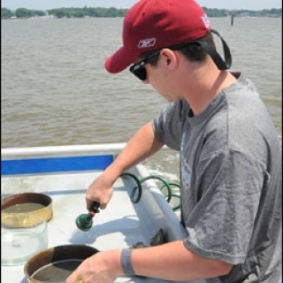Eight students will be presenting the summer work at the Ocean Sciences Meeting in March 2022!
Ashton Imlay, Tufts University
Class Year:
2011Mentor:
Hongsheng Bi, Ph.D.Project Title:
Spatial and Temporal Distribution of Atlantic Menhaden Brevoortia tyrannus, Larvae in Coastal Atlantic Waters
Abstract:
Atlantic menhaden (Brevoortia tyrannus) is an important fish to both the estuaries and coastal ecosystems it inhabits at different life stages. It primarily feeds on phytoplankton and zooplankton at different stages, thus it provides filtering and a food source to estuaries, and supports the largest fishery on the Atlantic coast. The recruitment of Atlantic menhaden to estuaries is highly variable. To begin to examine why that is, the spatial distribution of the larvae must be determined. To achieve this goal, I used bi-monthly ichthyoplankton survey data from Northeast Fisheries Science Center from 1971 - 2008. Results suggested that larval distribution shifted to the north in January-March, April-June, and July-September. However, the data from October through December showed a southerly shift. The relationship between the surface and bottom mean temperatures were also varied by time period. The January-March and July-September data showed northerly shift in abundance as water temperatures increased, the April-June data showed northerly shift in abundance as water temperatures decreased, and the October-December data showed southerly shift in abundance as water temperatures increased. Further research should examine the effects of large-scale climactic phenomena and other environmental factors on the spatial distribution of Atlantic menhaden larvae.




